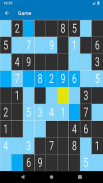










Sudoku

คำอธิบายของSudoku
Sudoku (digit-single) (originally called Number Place) is a logic-based, combinatorial number-placement puzzle. The objective is to fill a 9×9 grid with digits so that each column, each row, and each of the nine 3×3 subgrids that compose the grid (also called "boxes", "blocks", or "regions") contain all of the digits from 1 to 9. The puzzle setter provides a partially completed grid, which for a well-posed puzzle has a single solution.
Completed games are always a type of Latin square with an additional constraint on the contents of individual regions. For example, the same single integer may not appear twice in the same row, column, or any of the nine 3×3 subregions of the 9×9 playing board.
A completed Sudoku grid is a special type of Latin square with the additional property of no repeated values in any of the nine blocks (or boxes of 3×3 cells). The relationship between the two theories is known, after it was proven that a first-order formula that does not mention blocks is valid for Sudoku if and only if it is valid for Latin squares.
The general problem of solving Sudoku puzzles on n2×n2 grids of n×n blocks is known to be NP-complete. Many computer algorithms, such as backtracking and dancing links can solve most 9×9 puzzles efficiently, but combinatorial explosion occurs as n increases, creating limits to the properties of Sudokus that can be constructed, analyzed, and solved as n increases. A Sudoku puzzle can be expressed as a graph coloring problem. The aim is to construct a 9-coloring of a particular graph, given a partial 9-coloring.
Sudoku (หลักเดียว) (แต่เดิมเรียกว่า Number Place) เป็นปริศนาตัวเลขการวางตำแหน่งเชิงตรรกะและ combinatorial วัตถุประสงค์คือเพื่อเติมตาราง 9x9 ด้วยตัวเลขเพื่อให้แต่ละคอลัมน์แต่ละแถวและแต่ละ subgrids เก้า 3 × 3 ที่ประกอบด้วยตาราง (เรียกอีกอย่างว่า "กล่อง" "บล็อก" หรือ "ภูมิภาค") ประกอบด้วย ตัวเลขทั้งหมดตั้งแต่ 1 ถึง 9 ตัวติดตั้งตัวต่อปริศนามีกริดที่สมบูรณ์บางส่วนซึ่งสำหรับตัวต่อที่ถูกวางมีวิธีแก้ปัญหาเดียว
เกมที่เสร็จแล้วจะเป็นประเภทของลาตินสแควร์ที่มีข้อ จำกัด เพิ่มเติมเกี่ยวกับเนื้อหาของแต่ละภูมิภาค ตัวอย่างเช่นเลขจำนวนเต็มเดียวอาจไม่ปรากฏสองครั้งในแถวคอลัมน์หรือย่อยย่อย 3 × 3 ในเก้าของ 9 × 9
ตาราง Sudoku ที่เสร็จสมบูรณ์เป็นตารางละตินชนิดพิเศษที่มีคุณสมบัติเพิ่มเติมโดยไม่มีค่าซ้ำ ๆ ในเก้าช่วงตึก (หรือกล่อง 3 × 3 เซลล์) ความสัมพันธ์ระหว่างทฤษฎีทั้งสองเป็นที่รู้จักกันหลังจากพิสูจน์แล้วว่าสูตรลำดับแรกที่ไม่ได้กล่าวถึงบล็อกนั้นมีผลสำหรับ Sudoku ถ้าหากว่ามันใช้ได้กับสี่เหลี่ยมละตินเท่านั้น
ปัญหาทั่วไปของการแก้ปริศนาซูโดกุบนกริด n2 × n2 ของบล็อก n × n นั้นเป็นที่ทราบกันดีว่า NP-complete อัลกอริธึมของคอมพิวเตอร์จำนวนมากเช่นการเชื่อมโยงย้อนรอยและการเต้นสามารถแก้ไขปริศนาส่วนใหญ่ได้อย่างมีประสิทธิภาพ แต่การระเบิดแบบ combinatorial เกิดขึ้นเมื่อการเพิ่ม n ทำให้เกิดข้อ จำกัด กับคุณสมบัติของ Sudokus ปริศนา Sudoku สามารถแสดงเป็นปัญหาการระบายสีกราฟ จุดมุ่งหมายคือการสร้างกราฟ 9 สีให้กับ 9 สีบางส่วน


























